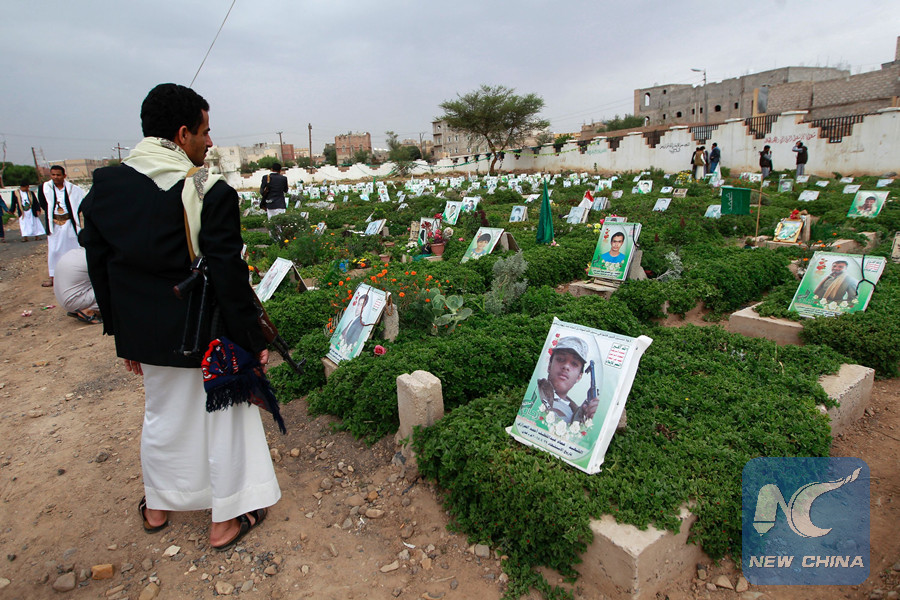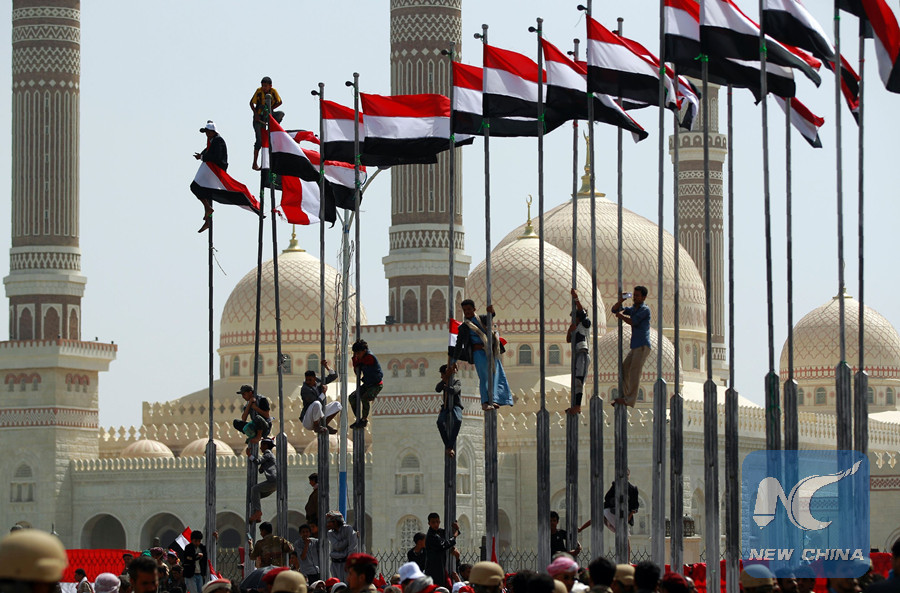
A Yemeni man stands near the grave of a relative at a cemetery in the capital Sanaa on July 6, 2016 after Eid al-Fitr prayers, which marks the end of the Muslim holy month of Ramadan. (Xinhua/AFP)
by Fuad Rajeh
SANAA, July 14 (Xinhua) -- One afternoon in January 2013, Ali Ali Al-Qawili, a 33-year teacher, left his workplace, the Khlaid Ibn Al-Waleed School, and went home to have lunch with his family.
After lunch, he called his cousin, Saleem, a 22-year-old college student who had a pickup truck, to take him and several friends to buy khat from the market.
After chewing khat later on the day, Ali and Saleem decided to take the friends to Sanhan, a district outside Sanaa, the Yemeni capital, recalled Ali's brother, Mohammed.
And then came the drone strike, which killed Ali, Saleem, and six others, about 4 km from Mohammed's village, Jihanah.
When Mohammed rushed to the site of the U.S. bombing, the Toyota Hilux was still burning, and the victims were beyond recognition.
"It was the most tragic scene," Mohammed Al-Qawili said. "I decided then to found the National Organization for Drone Victims."
That was only one of hundreds of such drone strikes in Yemen that were supposed to target terrorists but actually killed and maimed many civilians, including women and children.
"In our district, drones have also killed army officers, by mistake," Al-Qawili said.
Sometimes authorities would visit families of civilian victims, say sorry and offer financial compensation, he said. "But apologies and money cannot bring back the dead."
Since 2009, the United States have killed several hundred civilians through drone strikes and other covert counter-terrorism operations, reports said.
In two mis-directed strikes admitted by the Yemeni authorities, at least 56 civilians, including 24 children, were killed. The two attacks occurred in the provinces of Abyan in 2009 and Baidha in 2013.
On July 1, the White House announced that between 64 and 116 civilians, and between 2,372 and 2,581 combatants, were killed in U.S. strikes outside areas of active war zones from 2009 to 2015.
In its first public assessment of civilian casualties of U.S. counterterrorism strikes, the White House said as many as 473 U.S. strikes were conducted in Pakistan, Libya, Yemen, Somalia and North Africa.
Al-Qawili's National Organization for Drone Victims and rights organizations such as the Britain-based Reprieve, and the Bureau for Investigative Journalism, also headquartered in Britain, say many victims killed in U.S. drone operations were civilians.
"In almost every drone operation we have documented, there were civilian casualties, "Al-Qawili said.
The statistics published by the Bureau for Investigative Journalism put the number of confirmed drone strikes in Yemen at between 126 and 146.

Yemenis take part in celebrations marking the 26th anniversary of Yemen's 1990 reunification in the capital Sanaa on May 22, 2016. (Xinhua/AFP)
It said between 550 and 802 people were killed in the strikes, including between 65 and 101 civilians, and between 96 and 226 others were injured.
The Bureau said there were also between 89 and 106 other possible drone strikes that were not confirmed in Yemen, in which between 351 and 503 were killed and between 82 and 109 injured. Civilian casualties from those strikes were between 26 and 61.
The ongoing civil war and Saudi-led bombings have prevented organizations from following up on drone strikes in Yemen and getting accurate statistics.
"We can't give a statistic about it as we have been unable to go for field visits in Yemen," said Baraa Shaiban, a Yemeni rights activist and coordinator for Reprieve.
"What we are sure of is that there were civilian casualties in the past two years," Shaiban said. "We are communicating with relatives of victims."
And it appears that the drone attacks will not end any time soon.
The latest strike took place in Marib early this week, and in the past few weeks, several strikes were also reported in Shabwa, Mukalla and Abyan.
According to the London-based Reprieve, U.S. drone strikes in Yemen killed between 1,073 and 1,533 people during the period from 2009 to 2014.
As many of the drone strikes occur in remote locations, and due to the complete lack of transparency in the U.S. drone program, it is often difficult to accurately determine the number of casualties, especially civilian ones, Katherine Taylor, a Reprieve official, told Xinhua in an earlier interview.
Some observers said that the drone strikes are counterproductive not only because most strikes hit wrong targets but especially because they breach the sovereignty of other countries.
Mohammed Al-Ahmadi, a legal consultant for the Al-Karama, a rights organization, said the drone attacks are a collective punishment in countries like Yemen, as innocent people might fall victim at anytime.
"The drone war is illegal and violates all international laws," he said. "Laws call for arresting suspects, not executing them extrajudicially."
"Moreover, the post-strike trauma represents a huge problem," he added. "Many people suffer after drone strikes."
Hassan Arfaj, a college student in his 20s, is one of many Yemenis that would have to live with the nightmares of U.S. drone strikes for the rest of their lives.
Three of Arfaj's brothers were killed by drones in 2013; the fourth brother was killed by a drone in 2015.
In 2014, a drone targeted a car near his house, injuring three children. One of the three, a girl, died later of her injuries.

